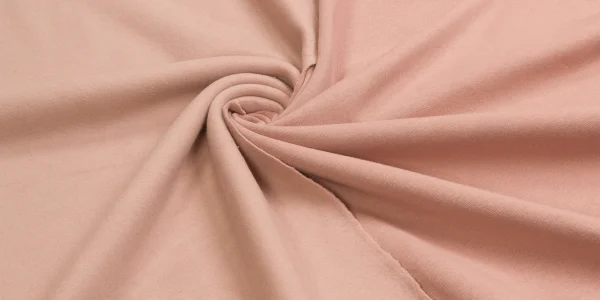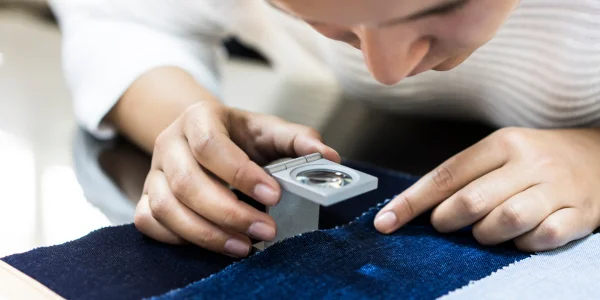Are you confused about the GSM written on the fabrics or clothing that you buy? Understanding what is GSM in clothing is important to judge the quality and durability of a fabric.
Want to know what makes a fabric truly exceptional? It’s all about weight and density (GSM). These factors influence a fabric’s durability and strength. Let Plain T Shirts India guide you through the world of fabric weight with our GSM guide and help you choose the perfect product.
GSM, or grams per square meter, measures a fabric’s weight. Generally, a higher GSM means a thicker, more durable material. For instance, denim boasts a much higher GSM than delicate chiffon.
When selecting clothing for specific sports or activities, GSM is crucial. It influences temperature regulation and performance.
GSM- Grams Per Square Meter, is a simple measure of fabric weight. Higher GSM generally means a heavier fabric. But don’t be fooled by this straightforward metric. Factors like fiber type, manufacturing process, and weave structure significantly impact a fabric’s quality and feel.
A thick cotton with a high GSM might be perfect for winter, while a lighter cotton with a lower GSM is ideal for summer. It’s clear that GSM is just one piece of the fabric puzzle.
GSM, or grams per square meter, plays a multifaceted role in shaping the fabric you wear. Let’s delve into its impact on three key aspects:

1. Thickness of the Fabric:
As you mentioned, GSM directly correlates to thickness. Fabrics with higher GSM pack more weight, translating into a thicker material. A 300+ GSM fabric will undoubtedly feel more substantial than its lighter counterparts. However, it’s worth noting that sometimes, fabrics with the same GSM might have slight variations in thickness due to the density of their fibers.
2. Quality of the Fabric:
While GSM gives you a good idea of weight, it doesn’t guarantee top-notch quality. Quality boils down to the fabric’s intended purpose. Here’s the breakdown:
- Summer Clothes: Lightweight fabrics (low GSM) are crucial for breathability and comfort in warmer weather.
- Winter Clothes: Conversely, heavier fabrics (high GSM) are preferred for winter garments as they provide better insulation and warmth – puffer jackets and twill coats.
3. Warmth of the Fabric:
This one goes hand-in-hand with thickness. Higher GSM fabrics offer superior warmth. This is why people naturally gravitate towards winter clothes with higher GSM ratings.

For professional and highly accurate GSM measurements, specialized testing equipment is used. However, to determine a fabric’s GSM by yourself, you’ll need:
- A precise scale
- Ruler or measuring tape
- Calculator
Steps:
- Cut a Square Sample: Cut a 10cm by 10cm square piece of the fabric.
- Measure Accurately: Ensure the square is exactly 10cm by 10cm.
- Weigh the Sample: Use the scale to determine the weight of the square sample in grams.
- Calculate GSM:
- Convert the square centimeters to square meters (10cm x 10cm = 100 cm² = 0.01 m²).
- Divide the weight of the sample (in grams) by the area in square meters.
Formula:
GSM = Weight of sample (grams) / Area (square meters)
Example: If your 10cm x 10cm sample weighs 1.6 grams:
GSM = 1.6 g / 0.01 m² = 160 g/m²
Important Considerations:
Accuracy: Using a precise scale is crucial for accurate results.
Sample Size: A larger sample might provide more accurate results, but a 10cm x 10cm sample is usually sufficient.
Fabric Consistency: Ensure the sample represents the overall fabric quality.
Multiple Measurements: For more precise results, take multiple measurements from different fabric parts.
GSM (Grams per Square Meter) is often misinterpreted as a direct indicator of fabric quality. While it’s true that a higher GSM generally correlates with a thicker, heavier fabric, it doesn’t necessarily equate to better quality.
Here’s why:
Fiber quality: The type of fiber used is paramount. A high GSM cotton fabric might feel different and have a different lifespan than a high GSM polyester fabric.
Weave structure: How the threads are interlaced impacts the fabric’s strength, and durability, and drape.
Finishing processes: Treatments like mercerization or dyeing can significantly affect a fabric’s feel and performance.
In essence, GSM is just one factor contributing to fabric quality. A high GSM fabric might be ideal for one purpose but unsuitable for another. When evaluating quality, it’s essential to consider the intended use of the fabric and other factors alongside GSM.

GSM in t-shirts directly correlates to the thickness and weight of the material.
Higher GSM indicates a thicker, heavier T-shirt. These are often more durable and suitable for colder weather.
Lower GSM means a lighter, thinner T-shirt. These are typically more breathable and comfortable for warmer climates.
Here’s a quick breakdown:
- Summer T-Shirt: Lightweight and breezy, opt for a 120-160 GSM.
- Regular T-Shirt: Versatile for most occasions, aim for a 160-190 GSM.
- Winter T-Shirt: Added warmth for chilly days, choose a 200-300 GSM.
- Sweatshirt: Cozy and comfortable, go for a substantial 300-400 GSM.
A fabric’s strength lies in its weave. The tighter the fibers are interlaced, the heavier and more robust the fabric becomes. This density is crucial for durability. To quantify this, we measure fabric weight or the material’s density per square meter. This is where GSM (Grams per Square Meter) comes in handy. It’s the key to understanding a fabric’s substance.
The GSM of a fabric influences its feel, drape, and suitability for various applications. Here’s a breakdown:
Lightweight Fabrics: These have a lower GSM, making them ideal for summer clothing, blouses, and scarves. Examples include chiffon, voile, and georgette.
Medium-Weight Fabrics: With a moderate GSM, these fabrics are versatile and suitable for a wider variety garments. Examples include poplin, cotton twill, and flannel.
Heavyweight Fabrics: High GSM fabrics are thicker and warmer, often used for outerwear, upholstery, and home textiles. Examples include denim, corduroy, and wool.
To give you a better idea, here are some approximate GSM values for common fabrics:
|
Fabric Type |
GSM Range |
|
Chiffon |
80-100 |
|
Voile |
90-120 |
|
Poplin |
120-140 |
|
Cotton Twill |
150-200 |
|
Denim |
180-300 |
|
Flannel |
200-300 |
|
Wool |
250-400+ |

GSM, or grams per square meter, is influenced by several factors:
Fiber type: Natural fibers like cotton, wool, and silk have different inherent weights.
Fiber fineness: Thinner fibers generally result in lower GSM fabrics.
Yarn count: The number of fibers twisted together to form a yarn. A higher count typically leads to a finer yarn and lower GSM.
Yarn twist: The tightness of the yarn twist affects its thickness and density.
Weave or knit structure: The interlacing or looping of yarns influences fabric weight.
Density of the weave or knit: A tighter knit results in a higher GSM.
Treatments: Processes like mercerization, sizing, and dyeing can alter the fabric’s weight.
Fabric finish: Brushed or textured finishes can add weight.
Impregnations: Coatings or finishes applied to the fabric can increase GSM.
In essence, GSM is a complex interplay of various factors that contribute to a fabric’s overall weight and feel.
Now, you’re armed with the knowledge of GSM and its impact on fabric weight and quality. This information lets you confidently select the perfect fabric for any occasion. Prioritize sustainable and high-quality pieces, and remember to vary your GSM choices to suit different seasons and preferences. At Plain T-Shirt India, we offer a range of t-shirts and apparel with varying weights to cater to your needs. Experience the difference a well-chosen GSM can make!
GSM, or grams per square meter, is a measurement of fabric weight. It determines a fabric’s thickness, warmth, and durability. A higher GSM usually indicates a thicker, warmer fabric, while a lower GSM means a lighter, cooler fabric.
A 200 GSM fabric is considered medium-weight. It’s suitable for a variety of garments, including t-shirts, shirts, and light jackets.
The GSM of 100% cotton can vary widely depending on the type of cotton, weave, and finish. It can range from around 80 GSM for lightweight fabrics to over 300 GSM for heavy-duty denim.
A 250 GSM fabric is typically considered a medium to heavyweight fabric. It’s often used for items like sweatshirts, jeans, and heavier-weight t-shirts.
Yes, a 240 GSM fabric is considered relatively thick. It’s suitable for cooler weather and garments that require more substance.
There’s no definitive answer as it depends on the desired outcome. A 75 GSM fabric is slightly lighter than an 80 GSM fabric, making it more suitable for very lightweight garments like summer tops.
The best GSM for a fabric depends on its intended use. For example, a lightweight summer dress might be around 100 GSM, while a winter coat could be 300 GSM or more.
A 210 GSM shirt is a good choice for cooler weather. It offers a balance of warmth and comfort.
A 180 GSM t-shirt is a popular choice for many people. It’s considered a medium-weight fabric, suitable for various climates and occasions.
Heavy cotton typically ranges from 200 GSM and above. However, the exact GSM can vary depending on the desired weight and thickness.
A 220 GSM shirt is suitable for cooler weather or as a layering piece. It offers a good balance of warmth and comfort.
It depends on your preference and the intended use. A 180 GSM shirt is lighter, while a 220 GSM shirt is warmer.
A 180 GSM fabric might be slightly heavy for very hot summer days, but it can be a good choice for milder summer weather or as a layering piece.
To check the GSM of a fabric, you can measure a square piece of the fabric and weigh it. Then, use the formula GSM = Weight (grams) / Area (square meters) to calculate the GSM. However, for accurate results, it’s recommended to use specialized testing equipment.



